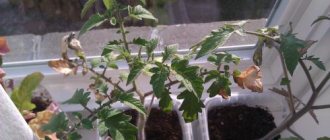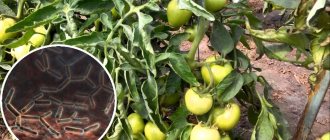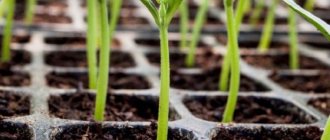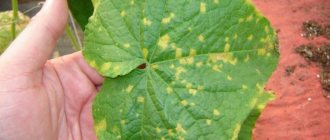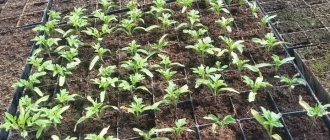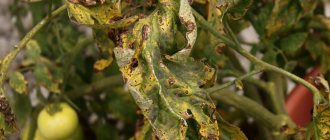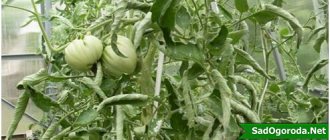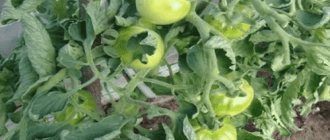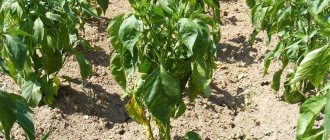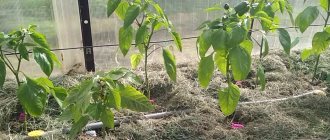Reasons why leaves on tomatoes dry out and turn yellow
Growing tomatoes is a painstaking process that requires a lot of effort, time and, of course, patience. It is especially difficult for beginner vegetable growers who do not have practical experience in agricultural technology in general for vegetable crops.
Tomatoes are grown both in open and closed ground. Those tomatoes that develop in greenhouse conditions are better protected from negative environmental influences. For example, bad weather. Tomatoes growing in a greenhouse do not need to be further protected from strong winds, sun or unexpected frosts. In some ways, care in such conditions is easier. It is enough to create the desired microclimate.
However, there are difficulties when growing tomatoes in a greenhouse. One of the common problems is drying and yellowing of leaves on tomatoes in a greenhouse. These are two different problems.
Often appear simultaneously or one after another. For example, first the leaves turn yellow and then dry out, or vice versa.
The content of the article:
1. What tomatoes need 2. Reasons why tomato leaves dry and turn yellow in a greenhouse 2.1 Microclimate in a greenhouse 3. Why leaves of tomatoes growing in a greenhouse dry out 3.1 Temperature and humidity 3.2 Lack of nutrients or excessive feeding of tomatoes 4. Possible diseases of tomatoes leading to to yellowing of leaves 5. How to help tomatoes 6. Damage to tomatoes by insect pests 7. Reasons for the appearance of yellowness on the leaves of tomatoes growing in a greenhouse 7.1 Injuries to the root system of tomatoes 7.2 Frequency of watering 7.3 With a lack of moisture 7.4 With excess moisture 7.5 Unbalanced plant nutrition 8. Diseases tomatoes, leading to yellowing of leaves 9. Damage to tomatoes by insect pests and yellowing of foliage
Tomatoes: what kind of culture?
The homeland of tomatoes is South America. This is an annual heat-loving plant of the Solanaceae family. Characteristics:
- stem - erect, slightly pubescent;
- flowers - yellow;
- ovaries - elongated, spherical;
- The fruits are round and juicy.
Tomatoes are fastidious plants. They need plenty of warmth and light. The optimal temperature for seed germination is +25-27 degrees, so in Russian conditions it is better to plant seedlings in greenhouses in early spring, because the growing season and development are quite long.
It is equally important to provide greenhouse tomato seedlings with adequate lighting. But the plants are undemanding when it comes to moisture, but you need to water them in moderation, otherwise the fruits will dry out and crack, and the ovaries will fall off. The seedlings will become frail, weak, and unstable to fungal diseases.
Tomatoes
Note! The leaves begin to turn yellow immediately when the root system is damaged or the seedlings outgrow. If you initially plant early, then when planted in open ground the root system will be thinned and tangled into a lump.
What do tomatoes need?
It’s worth saying a few words about what is required for tomato crops cultivated in greenhouse conditions.
Photo of yellowing foliage of tomatoes
Requirements:
- systematic watering;
- maintaining the required humidity level (60 – 70%);
- monitoring the temperature inside the greenhouse (from +23 to 30 degrees);
- ensuring sufficient access to light, excluding direct rays of the sun.
These conditions need to be created already at the initial stage of seedlings. From time to time it is necessary to carefully inspect the tomato bushes in order to take timely action if a problem is detected, for example, yellowing of the leaves.
Caring for tomatoes in a greenhouse - video
Important!
Drying and yellowing on tomato leaves is a serious problem that you need to immediately pay attention to and start looking for the cause of its appearance.
Reviews
The reviews from gardeners below indicate that yellowing of foliage is not a terrible problem and most often it can be dealt with.
Andrey Grigorievich, Bashkortostan district
I have been growing tomato seedlings on my windowsill for more than 10 years. I often encountered the problem of overgrown seedlings, since there are prolonged spring frosts, due to which it is not possible to transplant young bushes into an open garden bed. In order to help tomatoes cope with trouble and take root well after planting in open ground, I mulch the soil at the planting site. The mulch layer usually reaches 6-7 cm.
Margarita, Orenburg region
For almost 15 years, my mother and I have been growing tomatoes from seeds ourselves. What kind of problems have haunted us these years? It seems that tomatoes try to surprise us every year and present new “surprises”. In recent years, the foliage of the bushes often turns yellow. As far as we understand, the reason for this phenomenon in our case is an aphid invasion. To cope with the pest we use various insecticides. The most effective drugs are Confidor and Aktara.
Vasily Petrovich, Samara
My wife often plants tomatoes in the greenhouse. Even with such cultivation, problems often arise. Over the past year, the bushes have turned yellow and stretched out. I began to systematically apply nitrogen-containing fertilizers, and soon there was no trace of the problem. The leaves slowly began to turn green.
Natalia
Author
Ask a Question
Yellowing of tomato foliage is not a cause for concern. By finding out the cause of such trouble, you can quickly deal with the problem. Most often the foliage turns green again. When affected by a fungal infection, diseased bushes must be removed from the garden bed to avoid contamination of other crops. With the right approach to growing tomatoes, the plants will certainly delight you and your family with a rich and healthy tomato harvest! Health to you and your loved ones!
Reasons why tomato leaves dry and turn yellow in a greenhouse
Yellowing and drying of tomato leaves occurs for various reasons. Some only lead to yellowing, others lead to drying and curling of the leaves. In both cases, it is important to maintain the microclimate in the greenhouse, so this reason can be attributed to both cases.
Why do tomato leaves turn yellow in a greenhouse - video
Microclimate in the greenhouse
An inappropriate microclimate inside the greenhouse can destroy all tomato plantings.
The first thing you need to do is understand the construction of a greenhouse structure and follow the following rules:
- You need to build a greenhouse in a place well protected from the winds. Preference should be given to a site surrounded by buildings or garden plantings of appropriate height, for example, tall trees and shrubs. This is especially true during lunch, when the scorching sun is present. Such rays will heat the greenhouse and increase the temperature inside it in some cases to +45 degrees. The ovaries and flowers will begin to shed and yellowness will form on the leaves of the tomatoes.
- Replace the soil annually. After all, it is in it that fungal spores, bacteria, and infectious pathogens settle. When it is not possible to completely change the soil, it is spilled with a solution of potassium permanganate or boiling water a couple of days before placing tomato seedlings in it.
- When spring comes, disinfect structural elements, including treating all tools used in the greenhouse.
- Periodically you need to ventilate the greenhouse with tomatoes to evaporate excess moisture.
- If necessary, increase the humidity by simply spraying with a spray bottle. You can simply install open containers filled with water.
- Create a heating system that can be used if necessary.
Let's choose tomatoes!
Tomato Country delicacy Tomato Pride of Siberia Tomato King of the Giants
Attention!
The most favorable environment for the proliferation of fungi and infections is humidity and warmth. This applies more to the greenhouse, since it is here that there is such a problem as high humidity and high air temperature.
Failure to comply with planting deadlines
One of the reasons why tomato leaves turn yellow in a greenhouse may be that the seedlings are left on the windowsill for too long. This becomes noticeable in the appearance of the seedlings. The planting material reaches large sizes, and the leaves change their color from bright green to pale green, sometimes to yellow.
Basically, this signals that all the microelements necessary for normal development in the soil have been exhausted and the plant is experiencing a nutrient deficiency.
When planting seedlings in a greenhouse, you can also see that there is not enough space for the root system in the container. In the case of growing seedlings in containers, this can make it difficult to separate the planting material, further aggravating the process.
This can lead to the fact that after planting tomatoes in a permanent place of growth in a greenhouse, the roots die, and the leaves turn yellow and fall off along with the ovary.
Important! The optimal age of seedlings from the appearance of the first leaves to planting in the ground is considered to be from 50 to 60 days.
To correct the situation when tomato seedlings turn yellow after planting in a greenhouse, the plant needs to be fed. For this purpose, complex fertilizers are suitable, which are applied at the rate of 25-30 grams of substance per 1 m2. This will help restore the development of the root system and further growth of the plant.
Why do the leaves of tomatoes growing in a greenhouse dry out: possible reasons
Let's try to figure out, based on certain signs, what is the reason for the yellowing of the leaves and tops of tomatoes that affected your garden.
Temperature and humidity
A common cause of drying and curling of tomato leaves is increased air temperature from +35 degrees, lack of sufficient oxygen and lighting.
Photo of curling tomato leaves
Worth remembering!
The lack of light has a more destructive effect on the condition of tomatoes than heat. Therefore, for example, in those areas of the country where daylight hours are short, it is necessary to additionally use artificial lighting.
Lack of nutrients or excessive feeding of tomatoes
The next reason:
lack or excess of microelements and other nutrients. An important reason for wilting of tomato leaves is improper application of fertilizers. Excessive fertilization with organic matter, nitrogen, and herbal infusions is common. In such cases, the leaves begin to dry either from the edges or from the center.
Photo of excess nitrogen in tomatoes
When there is too much nitrogen, a rapid growth of green mass begins and the flowers drop. To restore the balance, water or spray with a solution of wood ash. Potassium fertilizers are sometimes used.
A lack of nitrogen is more dangerous for tomatoes, as it can lead to their death.
Photo of signs of potassium deficiency in tomatoes
Potassium deficiency also leads to yellowing of the green mass. This is the first sign that the soil lacks this microelement. To compensate for the deficiency, tree ash, potassium nitrate and other fertilizers are used.
Prevention measures
Tomato is the leading crop among vegetables that require preventive treatments. This is explained simply: carrying out activities from the beginning of the growing season reduces the tendency to disease to a minimum. Insect repellent treatments help avoid invasion and protect bushes from damage. Prevention begins long before planting in open ground areas.
Digging or plowing a plot of land for tomatoes in the fall. This technique promotes additional ventilation, exposure of the inner layers and the destruction of larvae that cannot tolerate cold. Addition of insecticides to soil. Admission promotes additional disinfection of the substrate and reduces the risk of infection.
Maintaining crop rotation and planting suitable neighbors. Tomatoes are not planted after tuber crops. It is recommended to plant herbs and flowers next to them, which help repel insects. Before sowing seedlings, seeds are treated with a manganese solution. The soil for seedlings is additionally treated with cold or calcined in the oven. Cleaning the area for planting from tops, leaves, burning garbage. In addition to preparation, site selection and seed disinfection, special treatments of bushes are carried out:
- After planting the seedlings, spray with a solution of boric acid prepared at the rate of 10 g per 10 liters of water.
- Outside root treatment to increase green mass with urea solution.
- For successful formation of ovaries, spray with yarrow solution.
- Feeding to improve the quality of fruits with the preparation “Tomato”, which is created on the basis of plant hormones.
Possible diseases of tomatoes leading to yellowing of tomato leaves and their wilting
Dry leaves can be a consequence of tomatoes being damaged by tobacco mosaic, late blight, curl virus, or fusarium wilt.
How to identify tomato disease by leaf - video
Tobacco mosaic.
The first sign of the disease is the appearance of spots on the leaves, which gradually spread to the entire plant and affect the fruits themselves, making them unsuitable for food consumption. When a disease is detected, you need to take action immediately, because its development occurs very quickly.
Photo of tobacco mosaic on tomatoes
Late blight.
It is a fungal disease. It is quite common among vegetable crops. The very first sign is the appearance of a white coating on the leaf plate. The lower parts of the leaves become dark, spots appear on them, and the leaves dry out and fall off.
Photo of late blight in tomatoes
Fusarium (or fusarium wilt)
can destroy tomatoes. The fungus penetrates through the soil into the root system and gradually spreads to the entire plant, penetrating the foliage and fruits. If the disease is present, you may notice rapid wilting, curling and falling of the lower leaves.
Photo of fusarium (or fusarium wilt)
Curly virus
is a viral disease that also causes tomato leaves to curl and wilt. First, you can notice a change in the color of the leaves, shredding of the green mass, and its curling.
Photo of curly hair virus
Fungal diseases
If the roots of the tomatoes are not damaged, and the soil is rich in all the necessary minerals, then the cause of yellowing is associated with a fungal disease.
- Fusarium;
- Late blight.
The manifestation of fusarium can be observed on tomato leaves in the form of loss of elasticity and changes in color. This disease is transmitted through contaminated seeds or garden tools. The fungus that causes this disease settles in the soil for a long period of time. High levels of temperature and humidity due to watering every day can cause this fungus to grow and multiply.
This disease can affect tomatoes at any stage of development from seedlings to adult plants.
The roots are initially infected, and then the stem with the entire system. "Previcura" and "Trichodermina".
Another disease, like late blight, appears on yellowed leaves in the form of brown spots, gradually moving to the fruits. To avoid the proliferation of this type of fungus, you should follow the rules for watering plants, avoiding water getting on the leaves. Drugs like Bordeaux mixture, Infinite and Tattu can become saviors.
How to help tomatoes
The first thing to do is isolate the damaged parts of the plants and burn them.
Tomato disease!
Top rot of tomatoes in a greenhouse
The second thing is to treat the plants with chemicals in case of severe damage in accordance with the instructions.
When the disease has not yet spread, non-traditional “folk” remedies are used.
Third, remember that prevention is better than cure, and therefore take preventive measures:
- maintain a favorable microclimate in the greenhouse (temperature, humidity);
- Carry out proper, systematic care (watering, fertilizing tomatoes).
Prevention will strengthen the immunity of tomatoes, and accordingly, minimize the risk of disease.
Harm to the root system by harmful microorganisms
Damaged roots of tomatoes can be caused by pests such as mole crickets and wireworms.
Such a lover of young roots as the mole cricket is able to get to them from her nest in the soil. "Grom" and "Medvetox". Among the natural solution options, you can use pepper or vinegar infusion (10 liters of liquid: 150 g of hot pepper, 10 liters of liquid: 2 cups of vinegar), which must be used to treat the pest minks.
. You can save yellow tomato leaves from this insect using a special preparation, such as “Bazudin”, and sawdust or sand added to it. This mixture is used to treat the soil around yellowed tomatoes in a greenhouse. . This method involves placing pieces of various vegetables, such as carrots, beets, and potatoes, at a 10-centimeter depth in the soil prepared for planting seedlings. First, these pieces must be strung on small sticks, and when burying the vegetables down, leave the tips on the surface. After 2 days, the workpieces with insects must be pulled out of the soil and burned.
Damage to tomatoes by insect pests
Insect pests are another reason why tomato leaves may dry out.
To determine the type of pest, you need to carefully examine the underside of the leaf blade. The most common causes of this problem are aphids, whiteflies, and spider mites.
Small black individuals localized in the folds of the plant are aphids.
It is very dangerous because it feeds not only on plant sap. The insect injects a substance into the plant itself, which leads to a change and disruption of the shape of the tomatoes.
Photo of aphids on tomatoes
Whiteflies live in entire colonies and are represented by small white insects. The larvae eat almost all the green mass. Their waste products are dangerous for tomatoes, as they infect them with fungus.
Photo of whiteflies on tomatoes
Spider mites are located on the bottom of the leaves
and is capable of infecting all tomatoes in just a few weeks.
Photo of spider mites on tomatoes
To combat pests, specialized insecticides, digging, soil replacement, and mulching are used.
Lack of minerals and trace elements
When tomato leaves turn yellow, the cause is a lack of nitrogen.
. This first appears in the form of small dots, which then turn into a large spot.
When tomato leaves turn light yellow, they may need manganese. Such minerals may be in short supply due to the presence of a significant proportion of lime in the soil.
. With a small amount of sulfur elements in greenhouse soil, yellowing of tomato leaves and their compaction can be observed. If a substance such as phosphorus is present in a small proportion, the leaves will eventually turn yellow and their tops will begin to die.
A problem such as a lack of minerals and trace elements can be easily solved by feeding the crop. An effective solution is a solution with slurry and ash (1 to 10).
Reasons for the appearance of yellowness on the leaves of tomatoes growing in a greenhouse
The appearance of yellowness on leaves can occur for various reasons.
Are your tomato leaves starting to turn yellow? What is the reason and what to do? - video
Here are the most common ones:
- inappropriate humidity and temperature conditions;
- non-compliance with the regularity and measures of watering (lack or excess);
- presence of damage to the root system;
- soil composition insufficiently enriched with useful substances;
- plant infection by fungus or bacteria.
All of the above factors can lead to yellowing of the leaves. First you need to establish the cause, and then choose a treatment. In each individual case, treatment will be different.
Injuries to the root system of tomatoes
Tomatoes have a very developed root system. Tomato roots can reach up to 1.5 meters in length, so the crop thrives during dry periods. Some of the roots are above the soil surface and therefore require systematic watering.
Causes of damage to the root system:
- At the seedling stage, containers for growing tomatoes that are too small are used, which leads to curling of the roots and reduces the ability to take root after planting in a new place.
- If the seedlings overgrow, adaptation also becomes difficult, which leads to the appearance of yellowness on the tomato leaves.
- Presence of insect pests. The most dangerous are wireworms and mole crickets.
How to help:
for better adaptation to new conditions, you need to fertilize tomato plants by spraying the foliage with a spray bottle.
Watering frequency
When yellowing begins at the bottom of the leaves of a plant and gradually spreads higher, the cause may be too wet soil or a lack of moisture in the soil. With a lack and excess of moisture, yellowing of tomato leaves manifests itself in different ways.
In case of lack of moisture
When tomatoes don’t have enough moisture, cracks appear in the soil, the shoots themselves become drooping, lethargic, and the leaves begin to droop.
Attention!
Some vegetable growers make the mistake of immediately increasing watering when yellowing is detected on tomato leaves. There is no need to do this. And if there are fruits, even more so. High humidity will cause cracking of the tomato crop.
If the soil is dry, smooth and gradual watering is carried out, that is, the humidity is increased gradually. And to avoid cracking of tomatoes, phosphorus fertilizers are applied to the soil.
EXCELLENT VARIETIES OF TOMATOES!
Gavroche Sparks of Flame Liqueur
With excess moisture
When the soil is waterlogged, this also has a bad effect on the condition of the tomatoes and foliage.
This manifests itself in the following:
- siltation of the soil, the appearance of moss;
- shoots become elastic;
- foci of infection appear on tomato plants.
CHERRY TOMATOES!
Tomato "Leopold" F1
To reduce soil moisture, you need to follow several rules when watering:
- watering in the early morning or late evening (before 06:00 and after 18:00);
- use settled water at room temperature for irrigation;
- Avoid getting water on the leaves and fruits of tomatoes, water at the root (or carry out drip irrigation);
- Water regularly, often 2 times a week is enough.
Attention!
Young plants need more water. As the culture matures, reduce its quantity.
Unbalanced plant nutrition
Leaves can equally turn yellow on tomatoes both in case of shortage and in case of excess of nutrients. All that is required is to apply fertilizing in a timely manner and periodically inspect the seedlings.
What tomatoes lack - Lack of nutrients - video
It is the leaves that signal whether the plant is receiving enough nutrients.
With yellowing of the lower leaves and lethargy of shoots, slow formation of shoots, as well as small size of leaves, absence of inflorescences, the tomato plant lacks such a microelement as nitrogen.
To eliminate it, add either nitrophoska or another mixture containing nitrogen in the composition.
With a lack of potassium, many light spots appear on tomato leaves
, which gradually grow and turn into one light spot that covers the entire leaf blade. Add potassium supplements.
When the leaves located at the top of the plant look drooping, the tomatoes need to be fed with manganese
, for which wood ash or cow dung is used.
Lack of sulfur leads to yellowing of tomato leaves.
They begin to dry and wither and at the same time become dense.
Copper deficiency
affects only old leaves and appears yellowish.
Causes of yellowing
Even an inexperienced gardener can immediately tell you that if the leaves of tomatoes turn yellow, then the culprit is bad weather conditions or various diseases. If you are faced with this problem, you need to urgently take some measures, otherwise yellowing may cause a decrease in yield. So what should you do if the tomato leaves turn yellow after you plant them in the ground? The first step is to find out why this happened. There are a variety of reasons. Sometimes the leaves turn yellow in a strange way, then fall out, and new young ones immediately grow in their place. In this case, you do not need to worry that the plants will suffer after transplantation, because this is a natural process that is not accompanied by any negative consequences.
No matter how hard you try to do everything carefully, minor damage to the seedlings still occurs during the transplantation itself. It is clear that damaged roots will not be able to cope with their direct responsibility: providing tomatoes with nutrients.
This cannot be avoided, but if the tomatoes take root, they will recover and turn green again. The transplantation process itself is also accompanied by exposure of tomatoes to lower temperatures. Interaction with dissolved minerals in the soil can also cause yellowing.
If you do not want your tomatoes to turn yellow, be responsible when it comes to transplanting. If planted in the ground too early, your seedlings may encounter such an unpleasant phenomenon as frost. Exposure of still weak plants to too low temperatures can be fatal.
The cause of yellowing of tomatoes can also be poor-quality transplantation. The formation of a dense ball of roots can lead to lack of nutrition and various plant diseases. As a result, the roots die. If such seedlings survive, the process of their establishment will be very long.
Tomato leaves may turn yellow due to lack of nutrition. If the plants do not have enough nitrogen, or they suffer from a lack of other essential microelements, then do not expect tomatoes to be abundant in beauty and health.
Therefore, the best prevention of yellowing is feeding. However, its maximum concentration should not exceed 1 percent. Otherwise, small pinpoint burns will form on the leaves, so you may only make the situation worse. The best option is to use liquid fertilizers, as they are safer. Each bush needs to be fertilized, but do not forget to allocate a sufficient amount of soil to it when planting (about 3 liters).
The answer to the question “why do tomato leaves turn yellow” may be more banal. Everything can always be much simpler than you think. And in this case, the reasons may lie in ordinary diseases, such as mole cricket.
The cause of wilting and death of tomatoes can also be fusarium (fungal disease). Tomatoes affected by Fusarium blight can be easily distinguished from healthy tomatoes as they are stunted and look as if they are lacking fluid. Yellowing of leaves is not the worst symptom of this disease. With fusarium, browning of blood vessels is observed on the cut of leaf petioles. This fungal disease develops at high humidity (65-75 percent), as well as at high soil temperatures (24-25 degrees).
To prevent plants from becoming infected with fusarium, follow a few simple rules:
- follow the principles of crop rotation when planting;
- do not allow water to get on the leaves, so you only need to water the tomatoes at the root;
- disinfect plant seeds before sowing.
Remember also that yellowing of plants does not always have to cause you to panic. If only the lower leaves have turned yellow, the tomatoes will be able to recover on their own, without your help. If yellowing has spread to the upper leaves, then the tomatoes should be treated with a nutrient solution that contains up to 1 percent salts (nitrates, phosphates). You need to spray the plants every day until they look normal.
So, we can summarize why tomatoes turn yellow, outlining the main reasons for this phenomenon:
- damage during transplantation;
- diseases (fusarium, mole cricket);
- lack of nutrients;
- unfavorable weather conditions.
Only by knowing why tomatoes turn yellow can you quickly eliminate this phenomenon. It’s a shame when you invest time and energy into transplanting seedlings, only to have them spoil your mood with the unpleasant yellowness of the leaves. But, fortunately, knowledge, as well as work, will help you grow a truly rich harvest.
Tomato diseases leading to yellowing of leaves
Fusarium (see description above)
can cause not only wilting, but also yellowing of the leaves. It occurs instantly and almost immediately leads to a change in the shade of tomato foliage. Dangerous for both seedlings and adult plants. After fighting fusarium, it is necessary to thoroughly treat the entire greenhouse, as its spores are very tenacious, including on greenhouse structures.
Late blight.
Occurs during the onset of cold weather, as well as at high temperatures and high humidity levels, and an unsuitable microclimate. The disease begins at the top of tomato plants when the tops turn brown and die after a while.
To help the vegetable grower, there is a wide variety of fungicides, as well as preventive measures related to the creation and maintenance of the proper microclimate in the greenhouse and proper care.
Provide proper care
Any changes in the color and condition of the sheet plates indicate problems
To minimize the likelihood of leaves falling, follow these simple rules:
Provide good sunlight to plants. Tomatoes should be in the sun for at least 6 hours a day, preferably more. This is the only way they can develop and grow normally. If there is a lack of sun in the cells, the processes of photosynthesis are disrupted, they begin to dry out, change color, and in the most advanced cases they fall off. It is best to locate on the south or west side of the house.
Maintain the correct watering schedule. If you carry out work frequently, excess moisture leads to inhibition or even rotting of the root system, plus the likelihood of fungal diseases increases sharply. You need to water no more than once a week and use a lot of liquid; this is the best option for the normal development of the root system.
Properly prepare seeds for planting. If the cause of the leaves drying and falling is a viral disease, then you will not help the plants in any way; they will all die. To eliminate such problems, seeds are disinfected in a solution of potassium permanganate or hydrogen peroxide
It is also very important to select nutritious soil, which you prepare yourself or buy ready-made.
If the leaves begin to dry out or turn white at the edges, then most often the reason is a lack of microelements
- Pick up seedlings. When plants are located in a small common container, over time they inevitably experience a lack of space. The seedlings begin to stretch, the stem becomes thinner, and the plants often shed their leaves - first of all, the lower shoots and cotyledon leaves fall off. It is best to use cups with a volume of at least 500 ml so that the roots have enough space.
- Apply fertilizing if necessary. If tomatoes lack nutrients, it is the leaves that suffer first. There can be many options; it is best to apply complex fertilizer for tomatoes; this is done once a week after picking, then repeated approximately once every 3 weeks. You can alternate traditional and foliar feeding.
- Monitor compliance with the temperature regime. Any sharp fluctuations are dangerous for young plants; high temperatures and bright sun cause burns and drying out of the leaves, and low temperatures provoke a disruption in the absorption of nutrients.
If the plants are damaged by bacteria, it is no longer possible to save them; they should be removed urgently so as not to infect healthy seedlings
The author of the video uses the drug Glyokladin to prevent fungal diseases on seedlings. It is effective and easy to use.
Damage to tomatoes by insect pests and yellowing of foliage
The yellowing of tomato leaves is caused by mole crickets and wireworms, which feed on the root part of tomatoes.
Photo of the mole cricket
The mole cricket loves soil that has been supplemented with organic fertilizers.
To find it, you need to dig up the ground a little, since it makes a nest at a depth of no more than 15 cm and feeds on roots from there.
This leads to yellowing of the leaves and eventual loss of yield. Insecticides are used to eliminate mole crickets.
The wireworm harms tomatoes by laying larvae near the plants, which, eating the tomatoes, gradually penetrate inside the stems. To eliminate the larvae, use a mixture of sawdust, sand and Bazudin.
Photo of wireworm
Tomato leaves can dry out or turn yellow for various reasons. When you notice the first signs of yellowing and wilting of tomato leaves, you should carefully examine the plants, diagnose the cause, and then take appropriate treatment measures. It is important to carry out timely prevention and systematically care for tomatoes so that the foliage is juicy and green, and the tomatoes themselves are healthy and tasty.
Recently searched:
Mechanical injuries
Damage to the roots during weeding or hilling can sometimes cause yellow leaves. An adult plant can hardly be damaged so much, but a young plant can be damaged.
When loosening the soil, no one will cut the main root. But small suction roots are often damaged. At the same time, the whole plant looks strong, and only the lower leaves begin to turn yellow.
It is worth watering the plant well, adding an anti-stress drug to the water and hilling the stem with damp soil. The additional roots that have grown will increase the feeding area, and the yellowing of the leaves will stop.
A good way to avoid this problem is to use mulch, which keeps the soil loose and moist.
Lack of fertilizers in the soil
With insufficient or incorrect feeding, yellowing of the leaf blades on tomatoes is often observed.
Nitrogen deficiency
The deficiency of this microelement becomes noticeable immediately. The leaves immediately begin to turn yellow and fall off. We must urgently take action, otherwise the plant begins to stretch out and the stems turn pale.
Fertilizing with nitrogen-containing fertilizers is carried out when planting bushes in a permanent place and at the beginning of the appearance of fruits.
The result of using nitrogen is an increase in green mass. Urea is good as a fertilizer. To do this, prepare a solution at the rate of 40 grams of urea per bucket of water. The bushes are sprayed with this solution.
Such fertilizing is carried out in order to improve the growth of tops. As soon as improvement in the condition becomes noticeable, feeding is stopped.
Mullein infusion, chicken manure, herbal tincture, compost are also very good as nitrogen-containing fertilizers.
Potassium deficiency
Young leaves curl into a tube. The edges of the old ones begin to dry out. Then the entire leaf darkens, the edges become yellow-brown. The spots grow, affecting the entire leaf.
Potassium nitrate is added for feeding. The preparation is prepared at the rate of one tablespoon of saltpeter per 10 liters of water. Watering is carried out by spending half a liter of solution per bush.
Root and foliar feeding with wood ash and humates is also good.
Magnesium deficiency
If there is a lack of this element, the leaves begin to yellow the veins, then the leaf blade curls.
Magnesium sulfate will help solve the problem. For irrigation, prepare a solution at the rate of 40 grams per 10 liters of water. Spraying can also be done. In this case, the solution is prepared by adding 20 grams of the substance to the same amount of water.
Magnesium is also good for better absorption of nitrogen, phosphorus and calcium.
Iron deficiency
Due to iron deficiency, chlorosis often develops. This manifests itself in the yellowing of the leaf blades, while their veins retain their color. Over time, such a plant loses its brightness of color and development stops.
It is possible to replenish the deficiency of the substance with a solution of iron sulfate. To do this, add literally five grams of the drug to a bucket of water. The bushes are sprayed with this solution. To consolidate the result, spraying is repeated every other week.
Phosphorus deficiency
With a lack of phosphorus, the leaf blades of tomatoes turn blue, then curl and rise upward. The branches become stiff and brittle, sometimes turning purple. The bush gradually turns yellow and withers.
In such cases, fertilizing with phosphorus-containing preparations is necessary. Superphosphate is very effective. To do this: pour a glass of superphosphate with a liter of boiling water, leave for 12 hours, and then dissolve in a bucket of water. Watering is carried out using half a liter per bush.
Zinc deficiency
The leaves on the tomato become spotted and grayish-brown. The size of the spots varies. The edges of the leaf blades curl upward, they begin to turn yellow and dry out. New leaves grow small, often covered with yellow spots.
Foliar feeding with zinc sulfate will help correct the situation. To do this, prepare a solution at the rate of five grams of the substance per bucket of water.
Diseases that affect culture
Diseases are also one of the causes of yellowing leaves. They occur in several cases: with excess moisture or improper care of plants. It is necessary to fight diseases with special drugs.
Fusarium
This disease is caused by fungal spores. The disease affects roots, stems, tops and fruits. Although the plant is affected at any period of its growth, it is especially common during the formation of fruits.
Symptoms of the disease include yellow leaves that curl and wilt. When cut through the stem, brown vessels will be visible. The disease affects the bottom of the plant, smoothly moving to the top.
If fusarium has already appeared on a plant, it must be destroyed so that the infection does not spread further. Preventive methods include treating seeds with fungicides before planting, as well as tilling the soil. Plants must be planted at a distance of 30 cm from one another, weeds must be controlled in a timely manner and the soil must be loosened.
Late blight
A fungal disease that manifests itself by the formation of brown spots on yellowing leaves.
If this disease is detected, the infected parts should be destroyed and the greenhouse should be ventilated to reduce humidity.
After this, healthy plants must be treated with biological preparations, for example, using Fitosporin or Trichophyte. After spraying, it is necessary to rinse the tomatoes that will be eaten especially thoroughly.
Chemicals “Quadris”, “Hom” and “Ridomil” can be used only if the crop begins to ripen in a month. They are also used after harvest to disinfect the greenhouse and soil.
For prevention purposes, you can use a solution of 15 drops of iodine, a liter of milk and 9 liters of water. Spraying with this product helps to form a film on the surface, thanks to which harmful bacteria cannot penetrate inside.
The appearance of pests
Tomatoes suffer from aphids, spider mites and whiteflies. These pests suck sap and vitality from plants. Their spread leads to yellowing of foliage and wilting.
Insects can be controlled by spraying. The preparations “Inta-vir” and “Iskra” are used if there is a month before the tomatoes begin to ripen. They will not harm the crop and soil, but will have a paralytic effect on the nervous system of pests.
"Biotlin" is used if the crop ripens in less than a month. This drug works faster.
